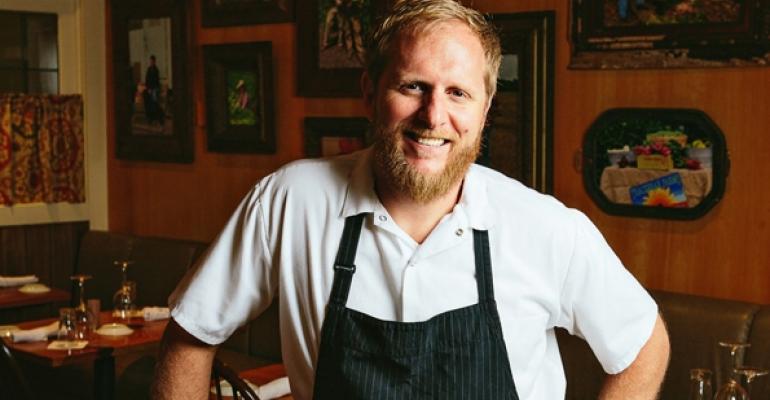Jacques Larson started cooking in Iowa City, Iowa, while studying English and history at the University of Iowa, but he has been cooking in the Southeast for most of the past 17 years.
He arrived in Charleston, S.C., in 1996 as the opening sous chef of the Peninsula Grill. In 2001 he moved to Greensboro, N.C., for his first executive chef gig and his first experience cooking Italian food, at Basil’s Trattoria and Wine Bar.
RELATED
• Restaurant customers, chefs embrace ceviche
• Chefs find more uses for ocean-friendly fish
• Seafood Trends at NRN.com
He returned to Charleston the following year, and except for a six-month stint at Mario Batali’s restaurants in New York City and several restaurants in Northern Italy, he has been there ever since.
Larson is currently the chef of Wild Olive, a restaurant that is Italian in spirit — and therefore focuses on local and seasonal produce and seafood — treating the southeastern Low Country as if it were a region of Italy.
He recently discussed the restaurant’s menu strategy, including its use of seafood, with Nation’s Restaurant News.
What is an example of a dish that combines Italian and Low Country culture?
One of my favorite dishes is kind of a play on shrimp and grits. It’s sautéed Carolina shrimp with housemade ’nduja sausage [a spicy sausage from the Italian region of Calabria] with a smoky paprika, oven-roasted tomatoes, and spinach and fried Geechie Boy polenta cakes.
What are Geechie Boy polenta cakes?
Kind of along the lines of Anson Mills. He uses heirloom grains and his mills are all refurbished antiques that he scrounges from all around the Southeast.
Last week we did a special with locally foraged chanterelle mushrooms. It was a bucatini with blistered tomatoes and sautéed chanterelles and a little Parmigiano-Reggiano. Very simple and straightforward. Whether we use local farmed, foraged or fished product, we try to do it within an Italian framework.
Does that include a lot of seafood?
A big thing down here is trying to use a lot of underutilized fish. When I moved here in ’96 I was blown away by the options, but we were already becoming more aware of the impact we were having on the oceans, and I feel a responsibility to use more sustainable seafood and fish.
We were the first green-certified restaurant in South Carolina, and we participate in the South Carolina Aquarium’s Sustainable Seafood Initiative [which seeks to educate consumers about local seafood options that are gentle on the environment].
As chefs we have an obligation to use resources that are sustainable. Our collective purchasing power is such that, to me, I wouldn’t feel right putting something on the menu that’s endangered or harvested in a way that’s destructive.
We’re a busy restaurant. I probably sell, fish alone, not including clams or crabs or anything else, at least 100-150 pounds of fish a week, and we’re not even a seafood restaurant. People come to Charleston; they want seafood. Over the course of time, it’s really important that we look at the bigger picture.
Considering the customer
Do you have to manage customers’ expectations about what type of seafood is available?
Being an Italian restaurant, people come in and ask why aren’t there mussels, and I guess mussels are pretty sustainable, but because of geographic proximity I’m much more likely to use Clammer Dave’s clams and oysters.
Clammer Dave is one of our treasures here, and he’s really begun to get a lot of recognition all up and down the East Coast.
We use vongole clams from him. They’re just steamed with a little white wine, butter, garlic, parsley and capers. We serve it with a little ciabatta.
Are your customers accepting of those limitations?
Some people want what they want, and they know it. Others see swordfish [overfished a decade ago] on the menu and ask if that’s okay. I think collectively everyone’s awareness of these issues is getting greater.
What are some local fish you like to use?
Triggerfish. It eats a lot of crustaceans, so it honestly tastes like scallop, crab or shrimp. In the winter we’ll pan-sear that with some lentils, maybe house-cured pancetta and spinach.
We also use wreckfish, which is a family member of grouper, and if you clean the bloodlines you can’t tell the difference. For a while it was incredibly overfished, but now it’s come back and it’s something you see on a lot of different menus here.
We pan-sear that with local tomatoes, okra, corn, butter beans, potatoes and a simple basil pesto.
What do you do when suppliers tell you one thing about how the fisheries are doing and the regulators tell you something else?
The supplier might say, ‘What do you mean? We see all kinds of grouper and snapper out there,’ but obviously they’re not doing all the tests. We listen to what NOAA [the National Oceanic and Atmospheric Association] and everyone else states. Even though fishermen are out there every day, you kind of have to listen to what the scientists are saying.
Contact Bret Thorn at [email protected].
Follow him on Twitter: @foodwriterdiary





